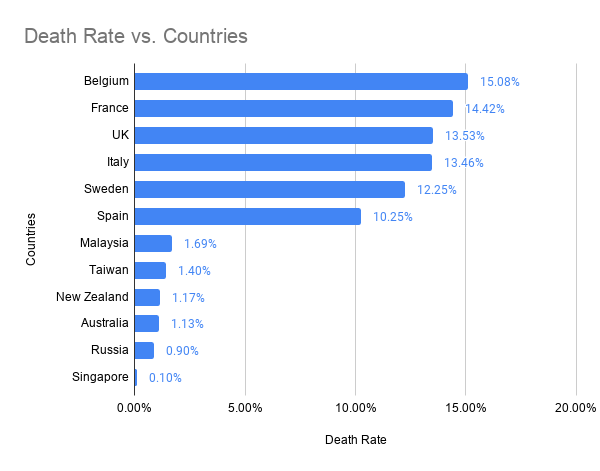COVID-19 Death Rate: The Highest and the Lowest in the World
The COVID-19 death rate is defined as the the number of known deaths divided by the total number of confirmed cases – varies widely by country right now. We have selected countries that are among the highest and the lowest in the world.
Data Source: Johns Hopkins, as of April 25, 2020
As of April 25, 2020, the global death rate is at about 7%. Belgium reported a death rate at about 15%, among the highest in the world. Similarly high in France, United Kingdom and Italy. The other end of the spectrum is Singapore, with a death rate of 0.1%, which is among the lowest in the world. Similarly low in Russia, Australia and Malaysia.
Why is the Number important?
The number impacts how we determine our management. It's important to understand risk factors for severe outcome - so whether that differs by sex or the presence of other diseases, race, ethnicity, income status, hospital etc. This will allow the policymakers to identify groups that need more attention and intensive management.
Reference: https://coronavirus.jhu.edu/map.html
COVID-19 is an emerging, rapidly evolving situation. Get the latest public health information from CDC: https://www.coronavirus.gov.
Get the latest research from NIH: https://www.nih.gov/coronavirus.
Category (Check out more related articles) > Coronavirus
Related: Can Supplements Help Against Coronavirus?
Data Source: Johns Hopkins, as of April 25, 2020
As of April 25, 2020, the global death rate is at about 7%. Belgium reported a death rate at about 15%, among the highest in the world. Similarly high in France, United Kingdom and Italy. The other end of the spectrum is Singapore, with a death rate of 0.1%, which is among the lowest in the world. Similarly low in Russia, Australia and Malaysia.
Why the Variation among Countries?
An important point to note is that there are a lot of cases that are not confirmed. People who have mild illness might be turned away or not be able to access testing. And we also know that there are a lot of people who are infected but don't develop symptoms, so that means that there's actually a much bigger denominator than what is reflected in this 'death rate'.
Why is the Number important?
The number impacts how we determine our management. It's important to understand risk factors for severe outcome - so whether that differs by sex or the presence of other diseases, race, ethnicity, income status, hospital etc. This will allow the policymakers to identify groups that need more attention and intensive management.
We’ve all been hearing that the elderly and those with pre-existing conditions (JAMA) are more likely to get hit the hardest by COVID-19. In fact, a research study was just published out of New York that shows that in a large hospital system, COVID-19 patients that needed hospital care (JAMA):
- The average age was 63 with half of this group being age 52-75
- They were 60% male and 40% female
- 57% had high blood pressure
- 42% were obese
- 34% had diabetes
Major risk factors like high blood pressure, obesity, and diabetes can be modified or controlled and treated. If you have high blood pressure, a high fever will increase the blood pressure further. What does it mean? Your risk of heart attack and stroke will increase. If you suspect that you have COVID-19 or being exposed to someone with COVID-19, please consult your doctor as soon as possible, especially if you are in the high risk group.
Reference: https://coronavirus.jhu.edu/map.html
COVID-19 is an emerging, rapidly evolving situation. Get the latest public health information from CDC: https://www.coronavirus.gov.
Get the latest research from NIH: https://www.nih.gov/coronavirus.
Category (Check out more related articles) > Coronavirus
Related: Can Supplements Help Against Coronavirus?



.png)
.png)





Comments
Post a Comment